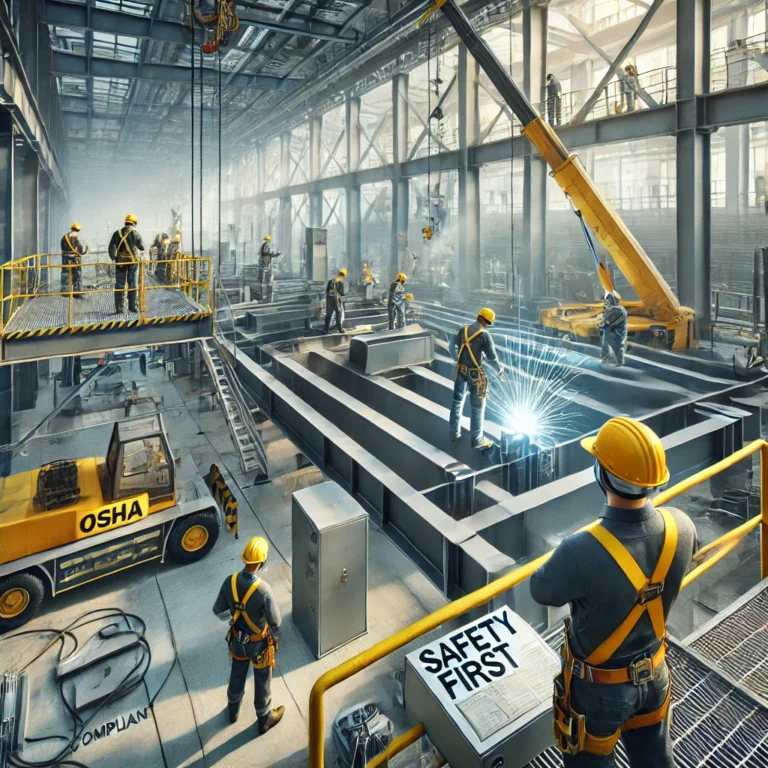Structural Fabrication Safety Standards: Compliance and Best Practices
Table of Contents
Imagine building a skyscraper without hard hats, harnesses, or quality checks. Sounds like a nightmare, right? In structural fabrication, safety is the foundation. Ensuring every beam, bolt, and weld complies with structural fabrication safety standards is essential to protect workers, maintain structural integrity, and meet industry regulations.
In this article, we explore the key structural fabrication safety standards, the importance of compliance, and how SRJ implements industry-leading safety protocols. We also review real-world case studies to demonstrate how compliance impacts safety and project success. Whether you’re new to the industry or a seasoned professional, adhering to these fabrication safety standards is crucial.

Key Structural Fabrication Safety Standards
Safety standards in structural fabrication ensure worker protection, maintain the integrity of the structure, and prevent accidents. These standards cover material handling, machinery use, and construction practices. The following are key safety standards relevant to structural fabrication:
1. OSHA Standards
The Occupational Safety and Health Administration (OSHA) enforces safety regulations for workplaces, including structural fabrication sites. Compliance with OSHA standards helps prevent injuries related to machinery, falls, and hazardous substances.
- Machine Guarding: OSHA requires protective guards on machines to shield workers from moving parts such as welders, cutters, and presses.
- Fall Protection: OSHA mandates fall protection systems, such as harnesses and guardrails, in areas where workers face fall risks.
- Hazard Communication: Workers must be trained to handle hazardous chemicals and informed about the risks involved. Learn more about OSHA safety regulations.
2. ANSI Standards
The American National Standards Institute (ANSI) provides voluntary guidelines for worker safety in structural fabrication. While ANSI standards are non-regulatory, they significantly influence safety practices.
- ANSI Z49.1: Safety in Welding and Cutting: This standard outlines the safety measures needed for welding and cutting, including ventilation and fire prevention.
- PPE Standards: ANSI sets requirements for the use of Personal Protective Equipment (PPE), such as gloves, safety glasses, and helmets. ANSI safety standards offer detailed information.
3. ISO Standards
The International Organization for Standardization (ISO) sets global standards for industrial safety and quality. Key ISO standards relevant to structural fabrication include:
- ISO 45001: Occupational Health and Safety Management: This standard outlines frameworks to manage safety risks in the workplace and reduce accidents.
- ISO 9001: Quality Management: While this focuses on quality control, it also emphasizes documented processes that help maintain safety in fabrications.
For more details, visit the ISO official website.
Why Compliance Matters in Structural Fabrication
Compliance with safety standards is critical not only to protect workers but also to prevent costly legal issues. Non-compliance can result in project delays, fines, and, in severe cases, legal action. Regulatory bodies like OSHA and ANSI play a crucial role in setting these standards.
Consequences of Non-Compliance
- Fines and Penalties: Non-compliance can lead to severe financial consequences.
- Legal Liability: Failure to comply with safety standards can lead to lawsuits from injured employees or clients.
- Project Delays: Safety violations can halt work and delay the project timeline.
To stay compliant, companies must perform regular safety audits and inspections, ensuring all fabrication safety standards are met.
SRJ’s Commitment to Structural Fabrication Safety
At SRJ, safety is not just a requirement; it’s a core value. Our team follows the highest safety standards, including OSHA, ANSI, and ISO, to ensure safe and compliant operations.
Safety Training and Education
Every employee at SRJ undergoes comprehensive safety training. This training includes the proper use of PPE, emergency response procedures, and safe machine operation.
- Induction Training: New employees receive thorough training on safety risks, standards, and protocols.
- Ongoing Training: We regularly update our training programs to ensure that our workers stay informed about the latest safety standards.
Advanced Safety Equipment
SRJ uses state-of-the-art safety equipment to protect workers on-site.
- PPE: Workers wear high-quality PPE like helmets, gloves, and respiratory protection.
- Automated Safety Systems: We invest in safety technologies, such as real-time monitoring and automatic shutdown systems for high-risk activities.
Regular Safety Audits
We conduct frequent safety audits to ensure compliance with structural fabrication safety standards.
- Internal Audits: Our in-house team inspects equipment and processes to identify any safety concerns.
- Third-Party Audits: Independent auditors review our safety protocols to ensure we meet or exceed industry standards.
Case Studies: The Impact of Compliance on Structural Fabrication Projects
Compliance with fabrication safety standards not only protects workers but also leads to successful projects. Below are examples of how adherence to safety standards has positively impacted real-world projects.
1. Oil Refinery Expansion
An oil refinery project in the U.S. adhered strictly to OSHA safety standards, including regular audits and emergency response protocols. The project was completed without a single major safety incident, proving the effectiveness of following fabrication safety regulations.
2. High-Rise Building Fabrication
A high-rise building construction project incorporated real-time safety monitoring systems to protect workers and the public. Compliance with OSHA and local building codes resulted in a zero-incident worksite.
3. International Fabrication Project
A structural fabrication project in a developing country faced challenges due to local safety standards and language barriers. Through collaboration with local experts and additional safety training, the project was completed with minimal incidents.
The Future of Safety in Structural Fabrication
As the industry evolves, so do the tools and technologies used to enhance safety.
1. Digital Safety Management
New technologies, such as AI-powered safety systems, are being integrated into structural fabrication to automatically detect hazards before they lead to accidents. These tools provide real-time data that allows for swift corrective action.
2. Virtual Reality (VR) Training
VR training programs are becoming more popular, allowing workers to practice safety protocols in a controlled environment. This advanced training improves their ability to handle real-world hazards effectively.
3. Sustainability and Safety
Sustainability practices are increasingly being integrated with safety. The use of sustainable materials and processes not only protects the environment but also enhances safety by reducing hazardous waste.
Conclusion: Safety First in Structural Fabrication
Compliance with structural fabrication safety standards is essential for protecting workers, ensuring project success, and avoiding costly penalties. At SRJ, safety is our top priority. By investing in the latest safety technologies, providing ongoing training, and adhering to strict safety protocols, we guarantee that every project is both safe and compliant.
Visit SRJ Piping India Pvt Ltd to learn more about our commitment to safety. Contact us today for a consultation on how we can help you maintain safety standards in your next project.
Concerned About Fabrication Safety & Compliance?
SRJ Piping India follows industry-leading safety protocols and compliance standards for structural fabrication excellence.
